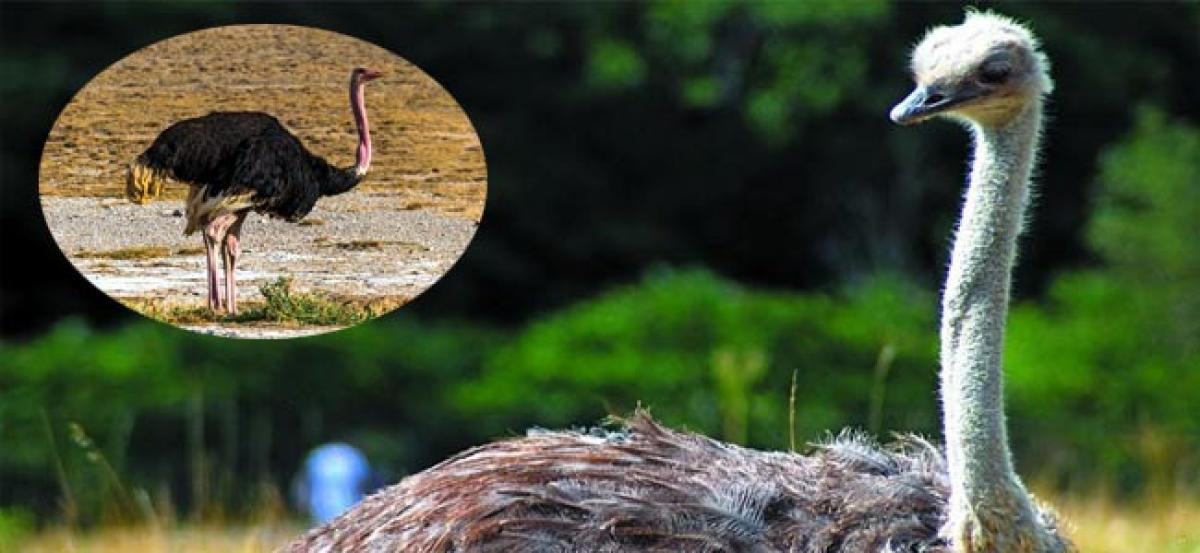Live
- AIIMS Darbhanga foundation today
- MVA most unstable vehicle with no wheels or brakes
- Ticket distribution: AAP's public feedback on 70 seats
- Since YSRCP Boycotting Assembly Session: Alliance MLAs told to play Opposition role too
- Reliance invests big in AP
- 2024 on track to be hottest year on record
- PM Modi’s visit to Solapur: Women applaud ‘Double-Engine’ government’s initiatives
- Nagarkurnool MLA Dr. Kuchukulla Rajesh Reddy Campaigning in Maharashtra Elections
- Wife Kills Husband with Her Lover: Details of Veldanda Murder Case Revealed by SP Gaikwad
- Strict Action on Violations of Food Rights: Telangana Food Commission Chairman Goli Srinivas Reddy
Just In

Ostrich, the flightless bird native to Africa, inhabited India about 25,000 years ago, claims a study. Though it is native to Africa, several geologists and archaeologists have over the time found ostrich egg shell pieces in India, mostly in Rajasthan and Madhya Pradesh.
Hyderabad: Ostrich, the flightless bird native to Africa, inhabited India about 25,000 years ago, claims a study. Though it is native to Africa, several geologists and archaeologists have over the time found ostrich egg shell pieces in India, mostly in Rajasthan and Madhya Pradesh. A DNA study of some partly fossilised ostrich egg shells was recently conducted at the Centre for Cellular and Molecular Biology (CCMB) here. "We have successfully analysed the ostrich egg shells in our 'ancient DNA' facility and established that the egg shells (found in India) are genetically similar to the African ostrich," CCMB's senior principal scientist Kumarasamy Thangaraj said.
"The carbon dating (of the ostrich egg shells) to determine the age shows that they are at least 25,000 years old," Thangaraj said. The study was conducted jointly by the scientists of CCMB, Indian Institute of Technology, Roorkee and others. The findings of the research have been published in the March 9, 2017 issue of science journal PLOS ONE. The origin and evolution of ostrich is widely attributed to the continental drifting of Gondwanaland or Gondwana. Around 150 million years ago, Gondwana was a super-continent comprising South America, Arabia, Africa, Australia, Antarctica, India and Madagascar of the present times, an official release said.
An initial break-up of this super-continent (during the Early Cretaceous period - 130 to 100 million years ago) separated Africa and Indo-Madagascar. This bio-geographical dispersion eventually led to hopping of ostriches in Africa through Eurasia (the combined continental landmass of Europe and Asia), via land route around 20 million years ago. However, the continental drift theory for the existence of ostriches in India was not proven scientifically, the release said. Over the time, several geologists and archaeologists discovered ostrich egg shell pieces, mainly in Rajasthan and Madhya Pradesh.
However, only morphological pattern of the fragile egg shell pieces is not sufficient to prove the existence of ostrich in India. The researchers thus analysed the mitochondrial DNA to come to the conclusion about the existence of ostriches in India, the release said. Phylogenetic (relating to the evolutionary development and diversification of a species or group of organisms, or of a particular feature of an organism) analysis of the DNA sequence revealed a 92 per cent identity of the fossil egg shells to the African ostrich species - Struthio camelus, it further said.

© 2024 Hyderabad Media House Limited/The Hans India. All rights reserved. Powered by hocalwire.com







